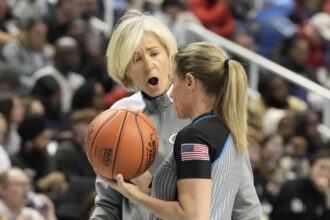The clash of blades against ice, the thunderous cheers echoing through arenas, and the blur of athletes rounding tight corners at breathtaking speeds—this is the electrifying world of short track speed skating, a discipline where Canada has long established itself as a formidable force on the international stage.
As we edge closer to the 2026 Milano Cortina Winter Olympics, Canada’s short track team stands at a fascinating crossroads. The program that has delivered 33 Olympic medals—making it our country’s most successful winter Olympic sport—is undergoing a significant transformation, blending veteran experience with emerging talent in pursuit of continued excellence.
The retirement of Charles Hamelin after the 2022 Beijing Olympics marked the end of an era. The five-time Olympic medalist, including three golds, left behind enormous skates to fill. Yet, as is often the case in elite sports, transitions create opportunities for reinvention and renewal.
“We’re entering a rebuilding phase, but with incredible potential,” notes Pascal Dion, who at 29 has stepped into a leadership role. “The young skaters coming up through our system bring fresh energy and fearlessness that combines well with the experience some of us veterans provide.”
This changing of the guard comes at a critical moment in the sport’s evolution. Short track has become increasingly competitive, with South Korea, China, the Netherlands, and Italy all fielding exceptional teams. The margins between podium positions and disappointment have never been thinner, often measured in mere thousandths of a second.
Canada’s approach to this challenge reflects both pragmatism and ambition. The program has invested heavily in sports science, using advanced biomechanics and physiological monitoring to optimize training regimens. This data-driven approach complements the intuitive wisdom passed down through generations of Canadian skaters.
The women’s team shows particular promise heading toward 2026. Kim Boutin, with three Olympic bronze medals already to her name, continues to demonstrate remarkable consistency at World Cup events. Alongside her, Courtney Sarault has emerged as a world-class talent, collecting silver medals at the World Championships and establishing herself as a threat in multiple distances.
“What makes our team special is the balance,” says Boutin. “We push each other constantly in training, which creates an environment where everyone improves. That internal competition translates to confidence when we face international rivals.”
On the men’s side, Steven Dubois looks to build on his impressive three-medal performance from Beijing. His versatility across different distances makes him a cornerstone of Canada’s medal hopes. Behind him, a crop of promising skaters including William Dandjinou and Félix Roussel represent the future, already making their presence felt at World Cup competitions.
The road to Milano Cortina presents unique challenges. The Canadian program must navigate the delicate balance between immediate results and long-term development. This tension is evident in selection processes for World Cup teams, where coaches must decide whether to prioritize experience or provide competitive opportunities to rising stars.
This season serves as a crucial midpoint in the Olympic cycle. Results now won’t necessarily predict outcomes in 2026, but they establish momentum and confidence. They also determine funding allocations—an often overlooked but vital component of Olympic success.
The unpredictable nature of short track adds another layer of complexity to medal projections. The sport is notorious for its crashes and disqualifications, where split-second decisions by officials can dramatically alter results. This volatility means that mental resilience becomes as important as physical preparation.
“You have to embrace the chaos,” explains Dion. “We train for every scenario, but ultimately, you need to adapt instantly when the unexpected happens. That’s what makes short track both frustrating and beautiful.”
Beyond individual performances, Canada’s relay teams have traditionally excelled on the Olympic stage. The collaborative nature of these events—where timing, transitions, and teamwork are paramount—plays to Canadian strengths. The men’s 5,000m relay team claimed silver in Beijing, while the women narrowly missed the podium with a fourth-place finish.
As we look ahead to CO24 Trends, the evolving landscape of short track speed skating reflects broader shifts in winter sports. Countries are becoming more specialized, investing strategically in disciplines where they see medal potential rather than spreading resources thinly across all events.
For Canada, maintaining excellence in short track represents both a cultural tradition and a strategic priority. The sport connects to our national identity—speed, ice, resilience against harsh conditions—while delivering consistent international success.
What makes this Olympic cycle particularly intriguing is watching how Canadian coaches balance tradition with innovation. The fundamentals of short track technique remain constant, but equipment technology, training methodologies, and tactical approaches continue to evolve.
“We respect our heritage in this sport,” says Dandjinou, one of the team’s rising stars. “But we’re not bound by it. Every generation gets to redefine what Canadian short track means on the world stage.”
As the team progresses through international competitions leading to 2026, Canadian fans can anticipate both electrifying successes and inevitable disappointments. The CO24 Culture of short track embraces these highs and lows as essential components of the Olympic journey.
Will Canada maintain its position among short track’s elite nations in Milano Cortina? The answer lies in the daily work happening now—in training centers across Quebec and Alberta, in the minds of athletes visualizing perfect races, and in the collaborative efforts of coaches, sports scientists, and support staff pursuing excellence.
One thing remains certain: when Canadian short track skaters take to the starting line in 2026, they’ll carry forward a legacy of excellence while writing their own chapter in this nation’s remarkable Olympic story. The blades are sharpened, the ice awaits, and the pursuit of speed continues.







